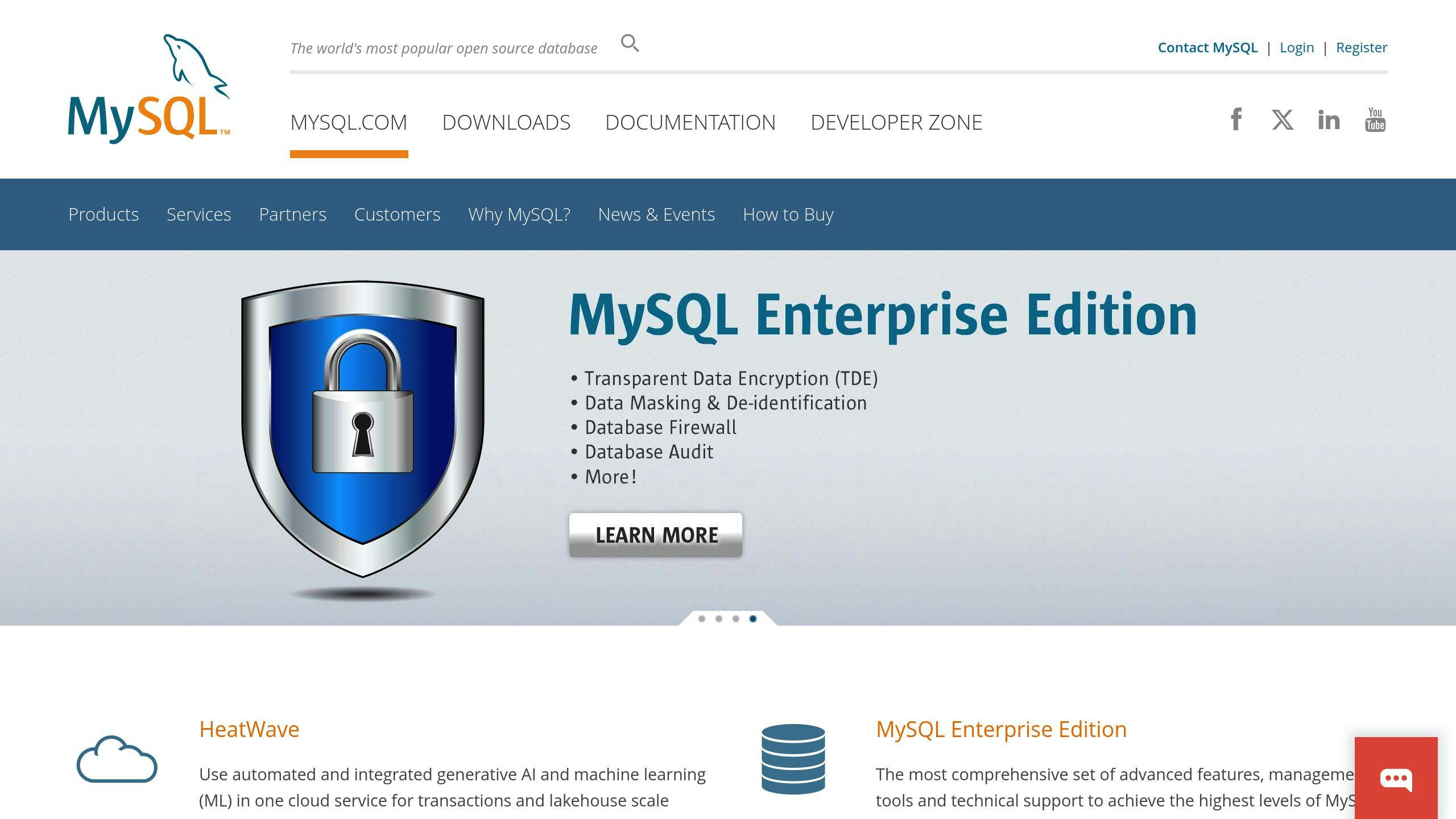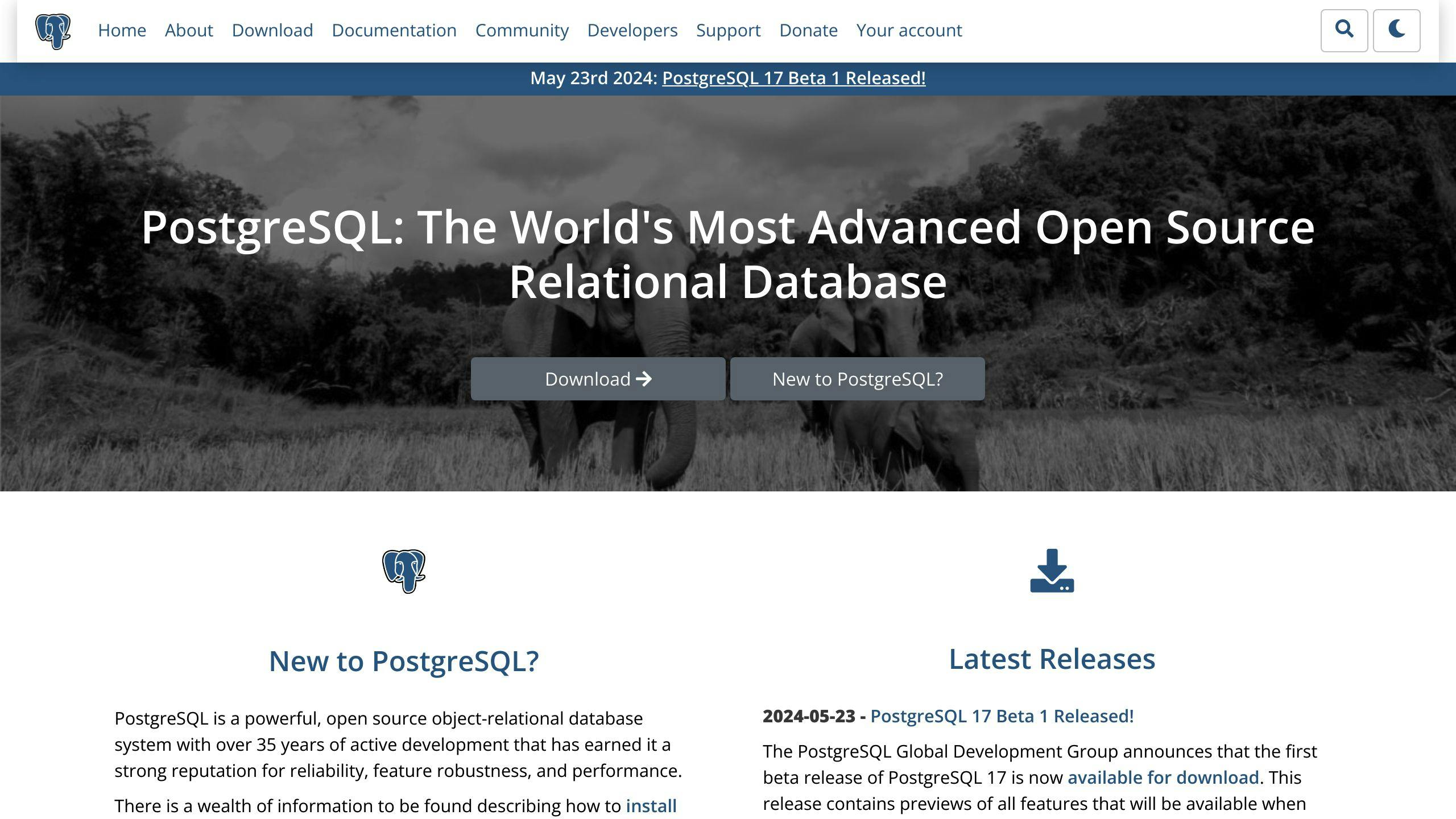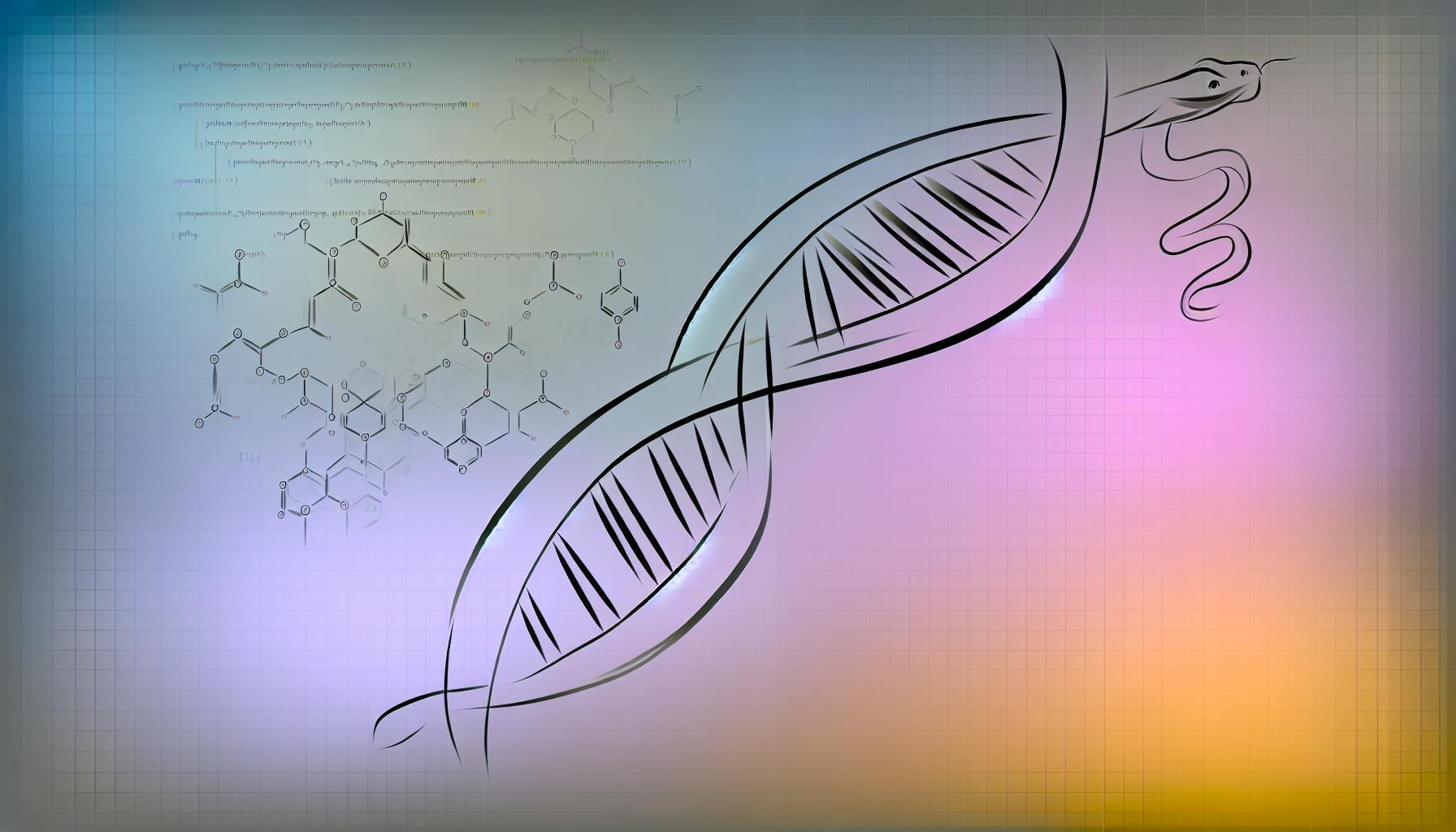MySQL and PostgreSQL are two popular open-source database management systems with different strengths and use cases:
MySQL
- Relational database management system (RDBMS)
- Simple and fast for read-heavy workloads
- Suitable for web applications, e-commerce, and online transaction processing
- Limited advanced features like JSON support and object-relational mapping
PostgreSQL
- Object-relational database management system (ORDBMS)
- Excels in write-heavy workloads and complex queries
- Supports advanced data types (JSON, XML, arrays, etc.)
- More robust security and advanced features like materialized views and indexing options
Quick Comparison
| Feature | MySQL | PostgreSQL |
|---|---|---|
| Database Type | RDBMS | ORDBMS |
| Performance | Read-heavy | Write-heavy, complex queries |
| JSON Support | ✓ | ✓ |
| Extensibility | Limited | Advanced |
| Advanced Querying | Limited | ✓ |
| ACID Compliance | ✓ | ✓ |
| Concurrency Control | Basic | Advanced |
| Object-Relational Support | ✗ | ✓ |
| XML Support | ✗ | ✓ |
| Indexing Options | Basic | Advanced |
Choose MySQL for simple, high-performance read operations in web applications and e-commerce. Choose PostgreSQL for complex data handling, write-heavy workloads, and advanced features like object-relational mapping and JSON support.
Database Management Systems Explained
A database management system (DBMS) is software that allows users to interact with a database, which is a collection of organized data. There are two primary types of DBMS: Relational Database Management Systems (RDBMS) and Object-Relational Database Management Systems (ORDBMS).
Types of Database Management Systems
| Type | Description | Example |
|---|---|---|
| RDBMS | Organize data into tables with rows and columns. Use SQL to manage and manipulate data. | MySQL |
| ORDBMS | Combine features of RDBMS with object-oriented programming languages. Support complex data types and additional features like inheritance and encapsulation. | PostgreSQL |
Understanding the Difference
RDBMS, like MySQL, store data in tables with rows and columns. Each row represents a single record, and each column represents a field or attribute of that record. RDBMS use SQL to manage and manipulate data.
ORDBMS, like PostgreSQL, combine the features of RDBMS with the capabilities of object-oriented programming languages. They support the storage and manipulation of complex data types, such as images, audio, and video. ORDBMS also use SQL, but they provide additional features that allow for more flexible and robust data modeling.
In summary, DBMS play a crucial role in storing and securing data within a structured format. Understanding the differences between RDBMS and ORDBMS is essential for selecting the right database management system for your project's needs.
MySQL: Simple and Fast

MySQL is a popular relational database management system (RDBMS) known for its ease of use and high performance. Its simplicity, scalability, and speed make it a favorite among web developers and organizations alike.
Key Features
MySQL powers some of the most demanding web, e-commerce, SaaS, and online transaction processing (OLTP) applications, including:
- Uber
- Booking.com
Architecture and Performance
MySQL's architecture is straightforward, making it easy to deploy and manage. It is a fully integrated transaction-safe, ACID compliant database with:
- Full commit and rollback capabilities
- Crash recovery
- Row-level locking
In terms of performance, MySQL 8.0 has shown significant improvements, making it an excellent choice for read-intensive workloads.
Benefits
MySQL's simplicity and speed make it an ideal choice for organizations and developers who need a reliable and high-performance database management system.
PostgreSQL: Complex and Customizable

PostgreSQL, also known as Postgres, is a powerful open-source relational database management system (RDBMS) that offers a rich set of features, making it an ideal choice for complex and demanding applications.
History and Evolution
PostgreSQL's history dates back to 1996, and since then, it has evolved into a highly advanced and feature-rich database management system.
Key Features
PostgreSQL's extensibility is based on its catalog-driven operation, where users can modify system catalogs to extend the database's functionality. This allows developers to add custom functionality to the database using various extension mechanisms, including:
- User-defined functions (UDFs)
- Custom data types
- Procedural languages
- Foreign data wrappers (FDWs)
Transaction Support
PostgreSQL's strong support for transactions is another key feature that sets it apart from other database management systems. Its multi-version concurrency control (MVCC) enables simultaneous write operations and reads, making it an excellent choice for applications that require high concurrency.
Data Types
PostgreSQL's support for advanced data types, such as:
| Data Type | Description |
|---|---|
| Arrays | Store collections of values |
| JSON | Store JSON data |
| Geometric | Store geometric data |
makes it an ideal choice for applications that require complex data modeling.
Conclusion
PostgreSQL's complexity and customizability make it a powerful tool for organizations that require a robust and scalable database solution. Its ability to handle complex queries, large data volumes, and high concurrency make it an excellent choice for demanding applications.
Licensing and Community Support
When choosing between MySQL and PostgreSQL, it's essential to consider their licensing and community support.
Licensing
MySQL operates under the GNU General Public License (GPL), which means that any modifications or derivative works must also be distributed under the GPL. PostgreSQL, on the other hand, has a more liberal license, allowing users to modify and distribute the software without restrictions.
Community Support
MySQL has a larger community of users and developers, which translates to more available resources, tutorials, and support. According to the G2 review site, MySQL's community support is more readily available compared to PostgreSQL. However, PostgreSQL's community is still significant and active, with many contributors and users providing support and resources.
| Database | License | Community Support |
|---|---|---|
| MySQL | GNU General Public License (GPL) | Large, readily available |
| PostgreSQL | Liberal license | Significant, active |
In conclusion, when deciding between MySQL and PostgreSQL, consider the licensing and community support aspects. If you require a more permissive license and a larger community of users and developers, MySQL might be the better choice. However, if you prefer a more liberal license and a still significant community, PostgreSQL is a great option.
Technical Comparison: Features and Performance
Database Architecture
MySQL and PostgreSQL have different approaches to database architecture. MySQL's architecture is simpler and more flexible, making it easier to install and configure. PostgreSQL's architecture is more complex, allowing for extensibility and durability.
Features
Both databases support various features, but PostgreSQL has some advanced features:
| Feature | MySQL | PostgreSQL |
|---|---|---|
| Materialized views | Third-party tools/manual queries | Native support |
| Indexing types | B-Tree, Hash, Full Text | B-Tree, Hash, GiST, GIN |
| User-defined data types | Not supported | Custom data types (e.g., arrays, hstore, JSON) |
Performance
Performance-wise, both databases have their strengths and weaknesses. MySQL is known for its high-performance capabilities in read-heavy workloads, while PostgreSQL excels in write-heavy workloads. Additionally, PostgreSQL's support for advanced features like window functions and parallel queries can improve performance in certain scenarios.
In conclusion, when choosing between MySQL and PostgreSQL, consider the specific requirements of your project. If you need a database with advanced features and extensibility, PostgreSQL might be the better choice. If you require a database with high-performance capabilities in read-heavy workloads, MySQL could be the way to go.
sbb-itb-ceaa4ed
Data Security: Access Control and Protection
When it comes to data security, both MySQL and PostgreSQL have implemented various measures to protect your data from unauthorized access and breaches. In this section, we'll explore the built-in security features of both databases, including access controls, SSL support, and other mechanisms to safeguard your data.
Access Control Lists (ACLs)
MySQL uses access control lists (ACLs) to manage connections and queries. This allows you to grant specific privileges to users, ensuring that they only have access to the data they need. PostgreSQL offers a more advanced access control system, known as SE-PostgreSQL, which complies with SELinux policies to provide an extra layer of access controls.
Encryption and SSL Support
| Database | SSL Support | Encryption |
|---|---|---|
| MySQL | Supported, but not enabled by default | Supported |
| PostgreSQL | Proprietary SSL support | Supported, with integration with GSSAPI and Kerberos |
Authentication Methods
Both databases support various authentication methods, including:
- Username/password combinations
- SSL certificates
- External authentication services like LDAP and Kerberos
- PostgreSQL also offers row-level security and multi-factor authentication
In conclusion, while both MySQL and PostgreSQL have robust security features, PostgreSQL's advanced access control system, encryption capabilities, and authentication methods make it a more secure choice for enterprise-level applications. However, it's essential to remember that data security ultimately depends on how you use the database, rather than which database you use.
Scaling Databases: Replication and Clustering
When it comes to scaling databases, replication and clustering are crucial features to ensure data integrity and availability in distributed environments. Both MySQL and PostgreSQL offer replication and clustering capabilities, but they differ in their approaches and implementations.
Replication in MySQL and PostgreSQL
MySQL uses a master-slave replication system, where the master database logs all statements and the slave database replicates them. MySQL also supports master-master replication, where each server is a master database, allowing servers to replicate automatically and update data.
PostgreSQL, on the other hand, permits various types of replication through the use of third-party extensions. Streaming Replication is a popular choice, which allows for real-time replication between master and slave databases. The pg_basebackup utility simplifies the setup process, taking care of snapshotting the master and pulling data over the existing Postgres service port to sync with the slave.
Clustering Capabilities
MySQL and PostgreSQL both support clustering, which enables horizontal scaling and high availability. MySQL's clustering capabilities are built-in, while PostgreSQL relies on third-party extensions.
Key Differences and Considerations
| MySQL | PostgreSQL | |
|---|---|---|
| Clustering | Built-in | Third-party extensions |
| Replication | Master-slave and master-master | Various types through extensions |
| Sequence Management | Manual configuration | Global Sequence feature |
When choosing between MySQL and PostgreSQL for scaling and clustering, consider the following key differences:
- MySQL's built-in clustering capabilities vs. PostgreSQL's reliance on third-party extensions
- MySQL's master-master replication vs. PostgreSQL's Streaming Replication
- PostgreSQL's Global Sequence feature for automatic sequence management
Ultimately, the choice between MySQL and PostgreSQL for scaling and clustering depends on your specific use case and requirements. Both databases have their strengths and weaknesses, and careful evaluation is necessary to ensure the best fit for your application.
Data Handling: Types, Structure, and Indexing
When it comes to handling data, MySQL and PostgreSQL have different approaches to data types, table structure, and indexing options.
Data Types
PostgreSQL offers a wider range of data types than MySQL. It supports object-relational databases, which means it can store data as objects with properties. This is useful for applications that involve complex data structures and relationships. MySQL, on the other hand, is a purely relational database management system.
Here are some of the unique data types supported by PostgreSQL:
| Data Type | Description |
|---|---|
| Arrays | Store collections of values |
| Ranges | Store ranges of values |
| Intervals | Store intervals of time |
| JSON | Store JSON data |
| XML | Store XML data |
Table Structure
Both MySQL and PostgreSQL support standard relational database table structures, including primary and foreign keys, indexes, and constraints. However, PostgreSQL's object-relational capabilities allow for more flexibility in table design.
Indexing Options
Both MySQL and PostgreSQL support indexing, which can be used to speed up query performance. However, PostgreSQL offers more advanced indexing options, including:
| Indexing Option | Description |
|---|---|
| Expression Indexes | Indexes based on expressions or functions |
| Partial Indexes | Indexes on a subset of rows |
| Hash Indexes | Indexes using hash functions |
Here's a summary of the key differences:
| MySQL | PostgreSQL | |
|---|---|---|
| Data Types | Limited to traditional relational data types | Supports object-relational data types |
| Table Structure | Standard relational database table structure | Supports object-relational table structure |
| Indexing Options | B-tree and R-tree indexing | Advanced indexing options, including expression, partial, and hash indexes |
When choosing between MySQL and PostgreSQL for data handling, consider the specific requirements of your application. If you need support for object-relational databases or advanced indexing options, PostgreSQL may be the better choice. However, if you need a simple and fast relational database management system, MySQL may be sufficient.
Comparison Tables
Table 1: Feature Comparison
| Feature | MySQL | PostgreSQL |
|---|---|---|
| JSON Support | Supported | Supported |
| Extensibility | Limited | Advanced |
| Advanced Querying | Limited | Supported |
| ACID Compliance | Supported | Supported |
| Concurrency Control | Basic | Advanced |
| Object-Relational Support | Not Supported | Supported |
| XML Support | Not Supported | Supported |
| Indexing Options | Basic | Advanced |
Table 2: Performance Metrics
| Workload | MySQL Performance | PostgreSQL Performance |
|---|---|---|
| Read-Heavy | 30% faster | 20% slower |
| Write-Heavy | 20% slower | 30% faster |
| Mixed Workload | Comparable | Comparable |
Table 3: Security Features
| Security Feature | MySQL | PostgreSQL |
|---|---|---|
| Row-Level Security (RLS) | Not Supported | Supported |
| SSL Support | Supported | Supported |
| Access Control | Basic | Advanced |
| Data Encryption | Supported | Supported |
| Auditing and Logging | Basic | Advanced |
Note: indicates the feature is supported, indicates it is not supported.
Choosing the Right Database for Your Needs
When deciding between MySQL and PostgreSQL, consider your project's specific requirements. Both databases have strengths and weaknesses, and choosing the right one depends on your project's scope, performance needs, and scalability requirements.
Determining Your Needs
Before making a decision, ask yourself:
- What type of data will you store and process?
- How much data do you expect to store and process?
- Do you need advanced features like JSON support or object-relational mapping?
- What is your budget for support, maintenance, and development?
- Do you have existing infrastructure or compatibility requirements?
Evaluating Performance and Scalability
Consider the performance and scalability requirements of your project. MySQL is known for its high performance in read-heavy workloads, while PostgreSQL excels in write-heavy workloads and complex queries.
Considering Complexity and Support
Evaluate the complexity of your project and the level of support you need. MySQL is generally easier to set up and use, while PostgreSQL requires more technical expertise.
Strategic Planning for Remote Staffing and Team Integration
When working with remote teams, consider the database's impact on collaboration and communication. MySQL's simplicity and widespread adoption make it easier to find developers with experience.
Here's a summary of the key factors to consider:
| Factor | MySQL | PostgreSQL |
|---|---|---|
| Performance | High in read-heavy workloads | High in write-heavy workloads and complex queries |
| Complexity | Easier to set up and use | Requires more technical expertise |
| Support | Widespread adoption and simpler to find developers | More specialized knowledge required |
| Scalability | Suitable for large-scale applications | Suitable for large-scale applications with complex queries |
Ultimately, choosing the right database depends on your project's unique needs and requirements. By carefully evaluating your options, you can make an informed decision that sets your project up for success.
FAQs
How do MySQL and PostgreSQL performance compare?
MySQL and PostgreSQL have different strengths when it comes to performance. MySQL is great for applications with high traffic and read-heavy workloads. PostgreSQL excels in write-heavy workloads and complex queries, making it a better fit for applications that require advanced features.
Why do people prefer PostgreSQL over MySQL?
PostgreSQL is often preferred over MySQL because of its object-relational database capabilities. This allows for more sophisticated data types and inheritance of properties. While this makes PostgreSQL more complex to work with, it also provides more advanced features.
Here's a summary of the key differences:
| Database | Strengths | Weaknesses |
|---|---|---|
| MySQL | High performance in read-heavy workloads | Limited advanced features |
| PostgreSQL | Advanced features, object-relational capabilities | More complex to work with |
Ultimately, the choice between MySQL and PostgreSQL depends on the specific needs of your project.


